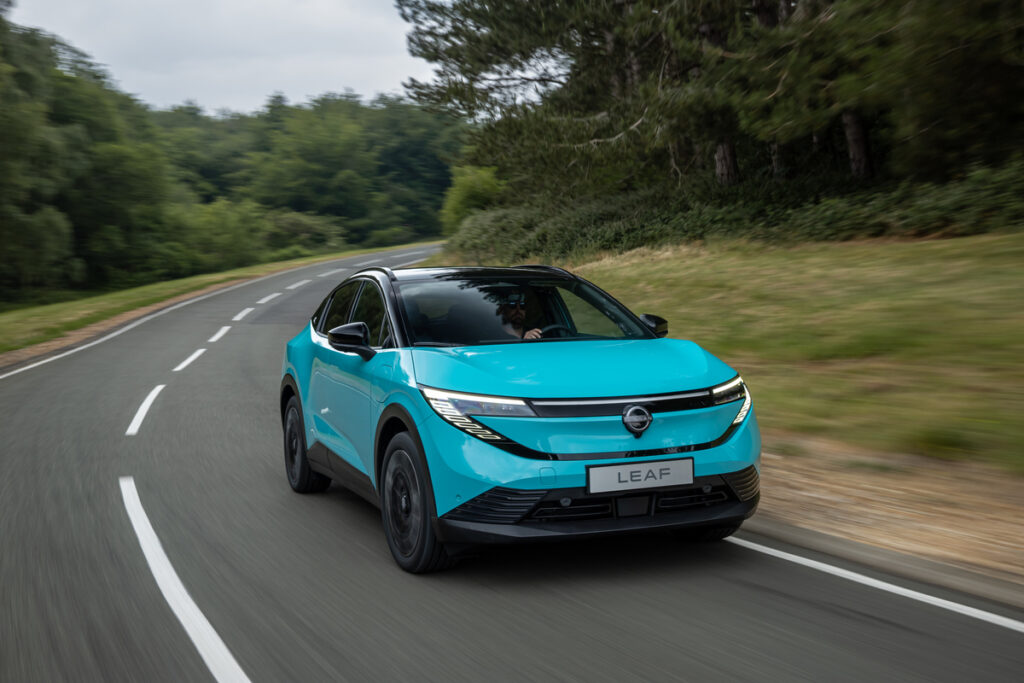There have recently been a series of press releases from Nissan UK about their forthcoming range of electrically powered vehicles. At the end of May Nissan UK announced the electric MICRA. Yesterday they launched what was described as “The all-new LEAF“:
Today marks the debut of the all-new version of the Nissan LEAF – a British-built electric car icon.
- The all-new Nissan LEAF is the next step in Nissan’s EV journey, building on its legacy as the world’s first mass-market electric car
- The sleek, aerodynamic, and spacious crossover design comes with two battery options for an impressive range of up to 375 miles (WLTP), ensuring confident driving for everyday and long-distance trips
- Delivers a fully connected mobility experience with Google built-in, dual 14.3” screens, and advanced driver assistance technologies
- Built in Sunderland, UK, as part of Nissan’s EV36Zero initiative, supporting a sustainable electric future for Europe
This third generation of the pioneering LEAF continues to lead the charge in Nissan’s electrification strategy with a sleek design, significantly extended range, and intuitive technology that is seamlessly integrated for today’s connected driver.
Engineered to tackle key barriers to EV adoption, the all-new LEAF has a substantially increased maximum range of up to 375 miles on a single charge for a no-compromise driving experience. It also offers enhanced charging speeds (up to 260 miles of range in 30 minutes) and a suite of technologies that make both driving easier and EV ownership more rewarding.
Since its debut in 2010, the Nissan LEAF has sold close to 700,000 units worldwide, earning its place in history as the world’s first mass-market electric vehicle. Today, Nissan is ushering in a new chapter for this nameplate, re-designed and re-engineered to meet the needs of modern EV customers, while remaining true to its innovative roots…
Designed at Nissan’s Global Design Studio in Atsugi, Japan, the all-new LEAF introduces a stylish silhouette that reflects its dynamic character and aerodynamic efficiency. With a drag coefficient of just 0.25, its sleek design optimises airflow to enhance both performance and range. Flush door handles, a flowing roofline, full under floor cover, and sculpted surfaces create a modern profile, while its signature front and rear lighting delivers a distinct, high-tech identity on the road.

Pretty pictures and low drag coefficients are all very well, but “What about the all new LEAF’s V2x capabilities?” I hear you ask. Heading for the small print I learn that:
The all-new LEAF is engineered for flexibility and confidence – whether in the city or on the highways. Customers can choose between two battery options, both delivering excellent range and real-world usability:
Battery Usable Capacity WLTP Range Standard 52kWh Up to 270 miles* Extended 75kWh Up to 375 miles* *Pending final homologation
With a DC fast-charging capability of up to 150kW, all-new LEAF can recover up to 260 miles* in just 30 minutes (*pending homologation). On the highway, it delivers more than 205 miles of range at 130km/h and thanks to the rapid DC charging, journeys over 500 miles can be completed with minimal time difference to ICE vehicles. This impressive range, combined with the spacious interior, makes it both a practical and comfortable choice as the main household car, capable of everything from daily commutes to long-distance travel.
Intelligent battery thermal management ensures fast, consistent charging in a range of temperatures, and now works in tandem with the In-Car Route Planner by Google Maps to automatically set the battery at the optimal temperature when approaching a fast charger, optimising both charging speed and efficiency. The integrated Google system also helps solve the hassle of planning long journeys by automatically identifying the most convenient charging stops along the way.
Equipped with Vehicle-to-Load (V2L) functionality, the all-new LEAF enables external device charging directly from the car, powering a variety of small to medium sized devices – such as kettles, portable lights, or electric grills – when camping or exploring the great outdoors. Leveraging an available accessory adaptor, customers can utilise an external V2L charging port to conveniently power devices, accessing up to 3.6kW of power.
Looking ahead, the all-new LEAF is Vehicle-to-Grid (V2G) compatible, such that in the future it will be able to send stored energy back to the power grid. This function will help customers reduce energy costs while supporting a more stable and sustainable energy system.
Whilst the final paragraph is of course very welcome given the lack of V2x functionality of Nissan’s Ariya, it is sadly lacking in detail. The press release is accompanied by this image of LEAF 3.0’s CCS2 charging port, including a legend for a series of colour coded flashing lights:
Nevertheless, I am now left hanging on those proverbial tenter hooks, wondering “Where, when and AC or DC V2G?”, amongst numerous other things.
Here’s Nissan’s “All-New Nissan LEAF” promotional video:
Emelia Hartford asks at around 7 min 30 secs “Did you know the LEAF can also power your life?”. Chris and Julie Ramsey then demonstrate the new LEAF’s vehicle-to-load capabilities. Emelia adds “In some markets you can even use the power of the LEAF, sending it back to the grid”. Sadly that doesn’t answer my questions about the UK market.
To be continued..


According to one of several Nissan Europe press releases for the all-new LEAF: